Table of contents
The red chili pepper ( chili paprika ) is known for its hot taste; it is used raw and dried as a spice ( organic ). The genus Paprika includes many species, the classification is not always clear, which is why the red chili pepper is classified as both Capsicum annuum and Capsicum frutescens (the hotter variety) .
Use of chili peppers (red) in the kitchen:
Fresh chili peppers (or chili peppers) in the colors red and green are particularly popular in South America and Asia. They can be used in many different ways to spice up dishes: raw, pickled (in oil or vinegar), dried whole ( chili peppers, sun-dried ) or dried and chopped (in the form of chili flakes , chili powder or cayenne pepper ). Chili powder is often a spice mixture of chili, cumin ,pepper, garlic and oregano . Cayenne pepper, on the other hand, is a pure powder made from cayenne chilis.
Chili peppers (red), cut into wafer-thin rings, refine raw salads or give other raw food dishes (e.g. raw chili with mushrooms ) an excellent spicy note. Cooked in stews (chili sin carne), vegetable stir-fries, soups, as a dip, in seasoning sauces or spice pastes, etc., it gives dishes a piquant to hot taste. Even bread, desserts, dark chocolate or tea (e.g. rosehip chili tea) can be given a little sophistication with chili peppers.
There are very mild varieties of the Capsicum annuum species (e.g. sweet peppers: red , yellow or green ) but also very hot ones (e.g. jalapeño ). The spiciness of a chili pepper varies greatly because it depends on numerous factors (variety, soil, climate and irrigation as well as time of harvest). 22,23 Neither the flesh nor the seeds, but the light placental tissue inside, on which the seeds are located, is the hottest. 22 Depending on whether this tissue is cooked, the degree of spiciness of the dish itself can be varied.
If the food is too spicy, there are several ways to reduce the spiciness. Adding potatoes and carrots (e.g. in soups or stews) makes for a milder taste. In general, fat, starch and sugar reduce the spiciness of chilis. 16 In addition to the frequently mentioned dairy products, vegan alternatives such as peanut butter or coconut milk can also have a good effect. Due to the high proportion of saturated fatty acids, however, we recommend avoiding such products or using them very sparingly.
Note: When working with chili peppers, it is recommended to wear gloves to avoid skin irritation. Do not get them in your eyes or wounds.
Vegan recipe for mango dip with fresh chili flakes:
Ingredients (for 1 glass of 350 ml): 150 g silken tofu, 1 ripe mango , possibly 2 tbsp agave syrup (organic), 1 tbsp coriander leaves (fresh), 2 tsp curry powder , 1 tsp mustard , ½ red chili pepper (raw, organic), 1 tsp turmeric , a pinch of salt .
Preparation: Put the tofu, mango, agave syrup, mustard and the spices (up to and including turmeric) in a blender and puree until smooth. Thanks to the sweet mango, you can also do without the agave syrup. Pour the mixture into a bowl and season with salt. The vegan and spicy mango dip can be kept in the fridge for 4-5 days if well sealed. It goes wonderfully with Asian rice dishes, e.g. filled rice rolls, or with raw vegetables.
Vegan recipe for rosehip chili tea:
Ingredients: ½ red chili pepper (raw = fresh), 2 tsp dried rosehip peel (organic), 2 tsp rooibos tea.
Preparation: Clean, deseed and wash the red chili peppers and cut them into fine rings. Put the chili, rooibos tea and rosehip peels in a pot with 250 ml of water and bring everything to the boil briefly. Cover the tea and let it steep for 4-5 minutes over a low heat. Use a sieve to separate the solid parts from the tea and pour the hot drink into a cup. Sweeten with honey or agave syrup as desired.
Vegan recipes with red chili peppers can be found under the note: " Recipes that have the most of this ingredient ".
| Not only vegans or vegetarians should read this: Vegans often eat unhealthily. Avoidable nutritional mistakes . |
Shopping - where to buy chili peppers (red)?
Chili peppers are in season in Central Europe from July to October , a little earlier for greenhouse crops. Fresh chili peppers are available all year round in supermarkets such as Rewe , Coop and Migros , but out of season they are often imported. To reduce the burden on the environment, it is advisable to use dried chili products in the winter and spring months. During the pepper season, the spicy fruits are also often available in supermarkets such as Edeka , Spar ( Interspar ), Denner , Volg , Lidl , Aldi and Hofer (usually as 'chili peppers red'). Organic raw chili peppers can be purchased in organic shops, organic supermarkets ( Denn's Biomarkt and Alnatura ) or specialty stores. You can also buy raw red chili peppers during the season at weekly markets, directly from the farmer or in vegetable subscription boxes. Asian shops and delicatessens often also sell fresh and processed chili products.
Chili peppers come in a wide range of colors. In general, however, you can assume that red chili peppers are riper than green ones : Most chili varieties are green to begin with and change color as they ripen. Many chili peppers turn red, while others turn orange-yellow or gold when ripe (e.g. the 'Hungarian Wax' and 'Yellow Hot Wax' varieties), and more rarely, purple or white. However, certain varieties are deliberately harvested earlier, while they are still green (e.g. jalapeños ). After harvesting, chilies do not ripen any further.
Ripe chili peppers are generally more aromatic and sweeter, but not always hotter than unripe ones (see "Growing in the garden" below).
Chili spice mills (chili flakes), cayenne pepper (ground chilies) and pickled chilies can be found almost everywhere, including organic ones in online stores.
Found in the wild:
There are a variety of wild chili varieties. The "mother of all chilis", Chiltepin ( Capsicum annuum var. glabriusculum ), still grows wild. Wild chili varieties include Capsicum rhomboideum , Vogel Aji, Ekirike, Cobincho, Capsicum galapagoense and Wild Brazil Chili. 1
Storage of chili peppers:
chili peppers should be stored raw at 8 °C. The total storage time is a maximum of 8 weeks. 2 Since consumers do not know when the farmers harvested the peppers, chili usually does not last as long after purchase. For larger quantities, a dark cellar or an unheated, dark room is suitable. In the industrial sector, a two-sided controlled atmosphere (with adjustable CO 2 and O 2 ratios) provides optimal storage conditions. 2
In dried form, whole red chili peppers can be kept for much longer than ground ones. For home use, the best method is to string the chilies on a string and hang them in a dark, cool and, above all, dry place. Thin-fleshed varieties are particularly suitable for this. For thicker-fleshed varieties, use a dehydrator. Dried chilies , chili flakes and ground chilies should be stored away from light, air and moisture so that they do not lose their flavor and spiciness.
Red peppers: Nutrients - Ingredients - Calories
100 g of raw red chili peppers have only 40 kcal. The water content is about 90%. Nutritional values of peppers: Carbohydrates make up about 8.8%, proteins 1.9% and fat (lipids) 0.44%.
The daily requirement of vitamin C (ascorbic acid) is covered by 180% with 144 mg per 100 g of chilli peppers (raw), but you certainly won't eat that much at once. The ascorbic acid content is similarly high in pointed peppers (raw). Green chilli peppers (242.5 mg/100g) and yellow bell peppers (183.5 mg/100g) have a lot of the vitamin. The vitamin C content varies considerably depending on the type of chilli; however, it has been scientifically proven that it gradually increases as the pepper ripens. 24
The vitamin B 6 (pyridoxine) content is 0.51 mg/100g, which is similar to that of Hungarian pointed pepper (0.52 mg/100g), but significantly lower than that of cayenne pepper (2.45 mg/100g) or paprika powder (2.14 mg). 3
Peppers contain the active ingredient capsaicin, which is responsible for their spiciness. The hotness of a chili pepper is determined using the Scoville scale. The Scoville content of sweet peppers is low at 0-10 Scoville units. Jalapeño chili is considered moderately hot (moderately pungent) with its 2,500-8,000 Scoville units. The Carolina Reaper variety (belongs to the species Capsicum chinense ) can reach up to 2.2 million Scoville units, a chili sauce called Mad Dog 257 No. 9 Plutonium reaches up to 9 million Scoville units (Scoville degrees or Scoville Units or Scoville Heat Units, SHU). 4 The Scoville scale, developed in 1912 by Wilbur L. Scoville , indicates the degree of dilution at which spiciness is no longer perceived. Pure capsaicin powder reaches 16 million Scoville units: to dilute 1 ml of pure capsaicin, you need 16 million milliliters (16,000 liters) of water. 18
The complete ingredients of red chili peppers, the coverage of the daily requirement and comparison values with other ingredients can be found in our nutrient tables. In the article Nutrients explained you will get a detailed insight into the topic. CLICK FOR under the ingredient picture.
Health aspects - effects:
Red chili peppers contain a high proportion of the secondary plant substance capsaicin (alkaloid). It is responsible for the hot taste of chili peppers. Capsaicin increases the secretion of gastric juice, stimulates digestion and salivation. 8
When you eat chili peppers, your body activates the nerves in the oral mucosa that are responsible for the perception of pain. To counteract the pain stimulus, your body releases endorphins. Chili can therefore lift your mood. In addition, eating hot chilies boosts energy consumption and can thus promote weight loss. Chilies cause hot flushes, sweating and increase blood flow to the mucous membranes. Capsaicin also has antioxidant, anti-inflammatory and antibacterial properties and can reduce the risk of cancer. 5,17,22
Red chili peppers contain other secondary plant substances such as flavonoids 8 and carotenoids. The pigments capsanthin, capsorubin and lutein, which are responsible for the red colour of peppers, act as antioxidants and can therefore also protect against UV light. 7
Dangers - Intolerances - Side effects:
Excessive consumption of capsaicin can have side effects. The Federal Institute for Risk Assessment assumes that an adult can tolerate a maximum of 5 mg of capsaicin per kg of body weight. For a person weighing 60 kg, this corresponds to 300 mg of capsaicin per meal. Chili peppers and preparations made from them can cause mucous membrane irritation (stomach irritation), nausea, vomiting, diarrhea or high blood pressure if too much is consumed orally. Tears, a runny nose and also breathing and swallowing problems are possible after eating chili peppers. 6
People with sensitive stomachs should eat red chili peppers with caution, otherwise they may experience heartburn, diarrhea and stomach pain. Children are also very sensitive to hot chili peppers. Consuming chili peppers can lead to serious poisoning in small children. 6
Even externally, high doses can cause local skin irritation such as burning, itching, overheating, redness, blistering and ulceration. Substances rich in capsaicin must not get into the eyes or wounds, as they can cause severe burning there.
If you overestimate your tolerance level for the spiciness of chili peppers, you should definitely not drink water to reduce the burning sensation, as capsaicin is not water-soluble, but fat-soluble. Fatty products (including dairy products), oil or carbohydrates in combination with oil, and sugar can help with a burning mouth. 16
The capsaicin contained in chili peppers can trigger allergic skin reactions as well as cross-allergies to tree pollen (e.g. birch, alder, hazel), 19 but cross-reactions with mugwort pollen are also possible. 9 Cross-allergies are usually milder than main allergies. Similar reactions are also observed with red, raw bell peppers .
Use as a medicinal plant: The
main ingredient used in medicine is the hot capsaicin. Internally, the alkaloid has a digestive effect, and externally, in the form of plasters and ointments, it helps against rheumatism and muscle pain. 10
Occurrence - origin - ecology:
The origin of the Capsicum species is thought to be in Central and South America, in the Andes region. Depending on the species, they have developed in different regions. 15 The wild plant Chiltepin (Tepin, Chiltecpin, Capsicum annuum var. glabriusculum ) was used 7,000 years ago as a means of payment, dye, spice and medicine. Columbus brought the pepper plant to Spain in the 16th century and from there it spread throughout Europe. The chili pepper reached Eastern Europe via Turkey, where the mild sweet pepper began to be cultivated in the 1950s. 11
Today, peppers are grown in subtropical and temperate zones all over the world. The main producers are Mexico, India, Indonesia, Thailand, Japan and China. 12 But chili peppers are also grown in Europe, especially in Spain, Italy and the Netherlands.
Growing in the garden or as a potted plant:
Red chili peppers can be grown very well in the garden or in a pot. Cultivation begins in February/March, but at indoor temperatures. You can soak the seeds in warm water for a few hours before sowing to increase germination. Place 3-4 chili seeds in the nutrient-poor potting soil per pot, cover the seeds with soil and place the pots in a bright location at temperatures above 20 °C. After about 10-20 days, the seeds will begin to germinate. The soil should always be moist. After two pairs of leaves have formed (four-leaf stage), you can prick out the chilis, i.e. carefully repot them into individual, slightly larger pots with nutrient-rich soil. 13
Chili plants thrive both outdoors and in greenhouses. Pepper plants can be transplanted into a greenhouse at the end of April or into the garden after the Ice Saints (mid-May). To do this, loosen the soil and fertilize it with organic fertilizer or compost. Plant the small plants 40 cm apart and attach them to plant stakes or strings. Press everything down well and water. Chili plants need a lot of sunlight and warmth, temperatures between 25 and 28 °C are ideal. In the greenhouse, higher temperatures produce better yields. Regularly ventilating the greenhouse guarantees pollination by wind and insects and reduces the risk of fungal diseases. Chili peppers can also be grown as a bush on the terrace or balcony (in large pots). The pepper bush or chili bush can grow up to 4 m high for some chili varieties. The ripening time of the chilis is between 100 and 120 days (from sowing). 13
According to a scientific publication from 2019, most chili varieties are at their hottest around 40 days after fruit formation (after which the level of spiciness decreases again). Some chili peppers are still green at this point and do not change color until a little later. 22 For certain varieties, the spiciness peaks even a few days earlier, and for a few varieties a little later. 23
Ecological aspects:
Conventionally grown red chili peppers often contain large amounts of pesticide residues. Imported goods from Thailand and Vietnam are the most contaminated, but Turkish, Spanish and Moroccan peppers also often have high residue levels. Organic peppers perform much better. No chemical-synthetic additives are permitted in organic farming . The significantly lower pesticide residues are usually due to drift. 14
General information about chili peppers:
The genus Capsicum belongs to the nightshade family (Solanaceae) and consists of around 30 different species, 16 of which 5 are mainly cultivated. The classification of species is not always clear. 21 The species Capsicum annuum includes mild pepper varieties as well as hot ones. However, there are even hotter varieties of the cultivated species Capsicum frutescens . In addition to countless wild forms , Capsicum baccatum, Capsicum chinense (Tabasco pepper) and Capsicum pubescens are also cultivated, mainly in Central and South America. The number of different chili varieties worldwide is estimated at 3,000-4,000 variations, which differ in size, shape, thickness of the flesh, color and capsaicin content. 15
Especially in agriculture, peppers are often divided into fruit types. Chili peppers differ in shape, length, spiciness and occasionally also in where they are grown. But here too there are differences in the classification.
From a botanical point of view, the chili pepper is a berry. 3-5 carpels that grow together form the fruiting body. This envelops the seeds inside. The fruit wall consists of three parts, the firm skin (exocarp), the pulp (mesocarp) and the inner wall (endocarp). Inside the berry is the much lighter placental tissue on which the kidney-shaped seeds sit. The placenta has the highest capsaicin content, while the seeds contain hardly any capsaicin. Many people mistakenly assume that the seeds taste particularly hot. In reality, however, it is the placenta that has the highest level of spiciness. It is often cut out together with the chili seed. 15
Alternative names for chili peppers:
chili peppers, red, also means: red pepper, red pimento, Spanish pepper, spice pepper, hot peppers, pepperoni, peppers, peperoncini, chili, chili pepper (chili pepper) or cayenne pepper (cayenne pepper). Historically documented names for Capsicum annuum are: Brunsilgenpéper, curry, Guinea pepper, hen pepper, cap pepper, Negro pepper, Brazilian pepper, Hispanic pepper, Indian-Kalickutt pepper and Polterhannes. 20 For chilis of the species Capsicum frutescens one also finds the name Beissbeere (biting berry).
Chili pepper (chili pepper, chili paprika or paprika chili) is a new word creation that is not listed in the Duden dictionary - the correct term is chili or the pod of the chili. It is probably the German equivalent of the English expression: chili pepper -> German Chili-Paprika. The frequently encountered spelling with a space ("Chili Paprika") is not orthographically correct.
In English, the hot chili pepper is called capsicum, red pepper, chili, chilli (plural: chilies or chillies) or cayenne pepper.
The drug name is also used as bloat fruit or Capsici fructus. 10
Keywords for use:
The oleoresin capsicum contained in chili peppers is the main ingredient in pepper spray. 6
Literature - Sources:

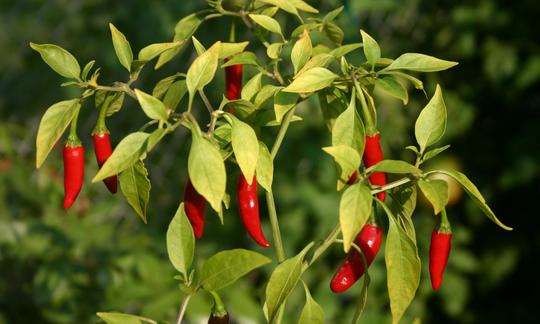

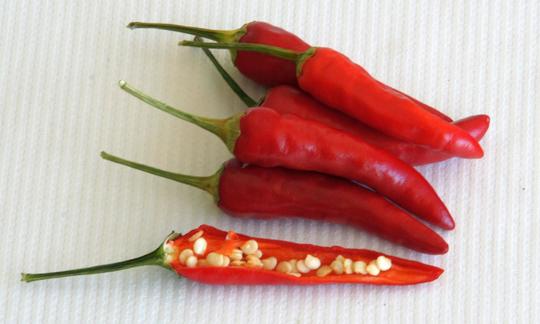

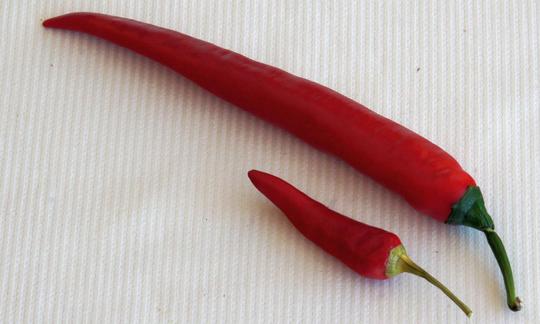

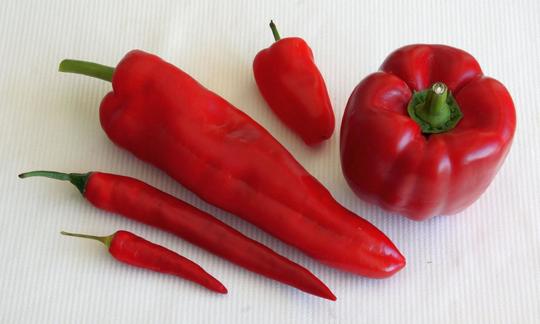

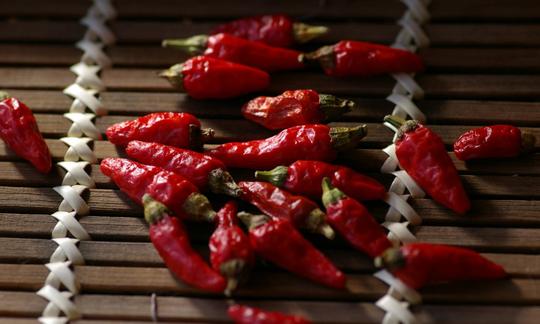

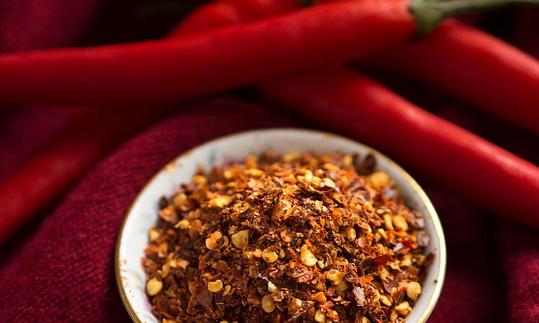


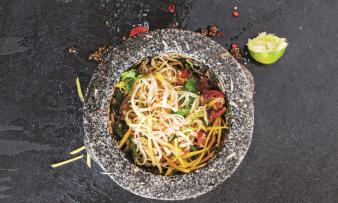
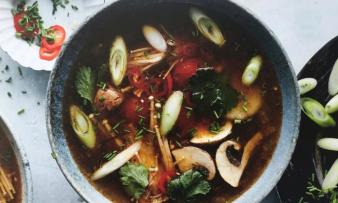





Comments